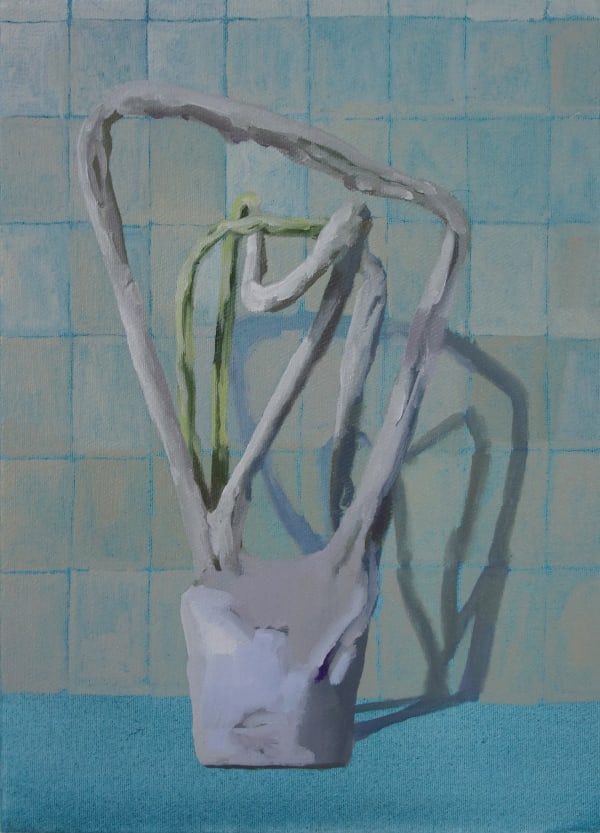Pi Artworks London is proud to present, Who Wants to Look at Somebody’s Face?, the first UK solo presentation of French artist, Maude Maris. Following on from two successful presentations in 2018 Recast, solo show at Espace à vendre, Nice and Double jeu, at FRAC Auvergne Collection, Musée d’Art et d’Archéologie d’Aurillac as well as the Anatolian Studies (solo), Embac Chateauroux, France (2017); Who Wants to Look at Somebody’s Face?, celebrates the role of photography in sculpture and painting, with reference to some of the greats of modern sculpture and how they used photography as an archive. The exhibition will feature 12 new paintings of playful compositions, titles of which relate to extracts from texts written by both Barbara Hepworth and Emily Dickinson.
Perhaps best known for hyper-realistic still-life paintings; Maude Maris, evokes images of voluminous intensity. The role of photography in relation to sculpture and painting is a musing that has impulsively drove her to explore important figures of modern sculpture such as Rodin and Henry Moore, Constantin Brancusi, Jean Arp and Ferdinand Cheval (The Postman). It is through such rigorous archival research that she began to look at their use of photography, exploring each composition innocently capturing the mundane, and pursuant of the day to day. Encapsulated within the intimate surroundings of their ateliers; no staging was required to spark her fascination. This is a path which organically led her to turn her gaze to the dame late Barbara Hepworth, whom, was not only one of the few female artists of that time with this focus, but also the way in which she would approach the parallels between sculpture with its basic principles of rhythm, poise, and equilibrium, inherent in human activity.
By examining the legacy of one of the UK's most celebrated British matriarchs of modern sculpture and after having found herself on what some may call a pilgrimage to the UK, between St. Ives and Yorkshire, we see the artist’s connection by subtly imbuing the subject matter ouvre, in homage to the muse before her.
Who Wants to Look at Somebody’s Face? celebrates the artist’s instantly recognisable technique, which will see the artist spilling into her characteristic pastelesque brushstrokes, but further exploring, far more vigorously, the particular tensions and relationships of form and colour, leaving them raw and non-binary. We will see the artist tirelessly abstract from archival images, unique compositions of her own, this exhibition also brings about a metamorphose in the artist’s trademark visual language, with residual contours and resolution of each assemblage bringing forth inanimate documentaries which realise new textures and forms wielded onto canvas.
About Maude Maris
Maude Maris, b.1980, Paris. Major exhibitions include Souvenirs de Téthys, (solo) Centre d’Art Chapelle Jeanne d’Arc, Thouars, France (2018); Anatolian Studies (solo), Embac Châteauroux, France (2017); O! Watt up, de Watteau et du Théâtre, Maison d'Art Bernard Anthonioz, Nogent-sur-Marne, France (2017); A claire-voix (solo), Ville de Thonon-les-Bains, France (2016); Votive (solo), Saint-Ange Residency, VOG, Fontaine, France (2016); Antique Romance, Pi Artworks London, UK (2016); Nemeton (solo), Musée des Beaux-arts, Rennes, France (2015); Along the Cornices, by Christian Aubert, Collector, Paris, France (2014); Dreaming of Vertigo, Raising the Doubt, Artothèque, Conseil Régional, Caen, France (2012). Major collections holding her work include Artothèque de Caen, France; Collection Fondation Colas Boulogne, France; FRAC Auvergne, France; FRAC Basse-Normandie, France; FRAC Haute-Normandie, France; Musée des beaux-arts, France and Collection Emerige, Paris, France.
Maude Maris begins production by making casts of small found objects, ranging from dolls and statuettes to branches and fossils. These reproductions are then grouped into families. She arranges these families to create a mise en scène, which she then photographs. She then paints this image, increasing its scale over 10 times, while also manipulating the object's surfaces, shadows, colours and depth so that the outcome is almost unrecognisable from the original model. Through the smooth perfection of its surfaces, Maris' paintings exist in silent and splendid detachment from the assembled objects which they depict. The creative process is conceived of here as a series of filters, which serve to create distance between the original objects and the final painting, and act in a manner analogous to - although quite different from - the mapping and modelling carried out by computer graphics systems.









